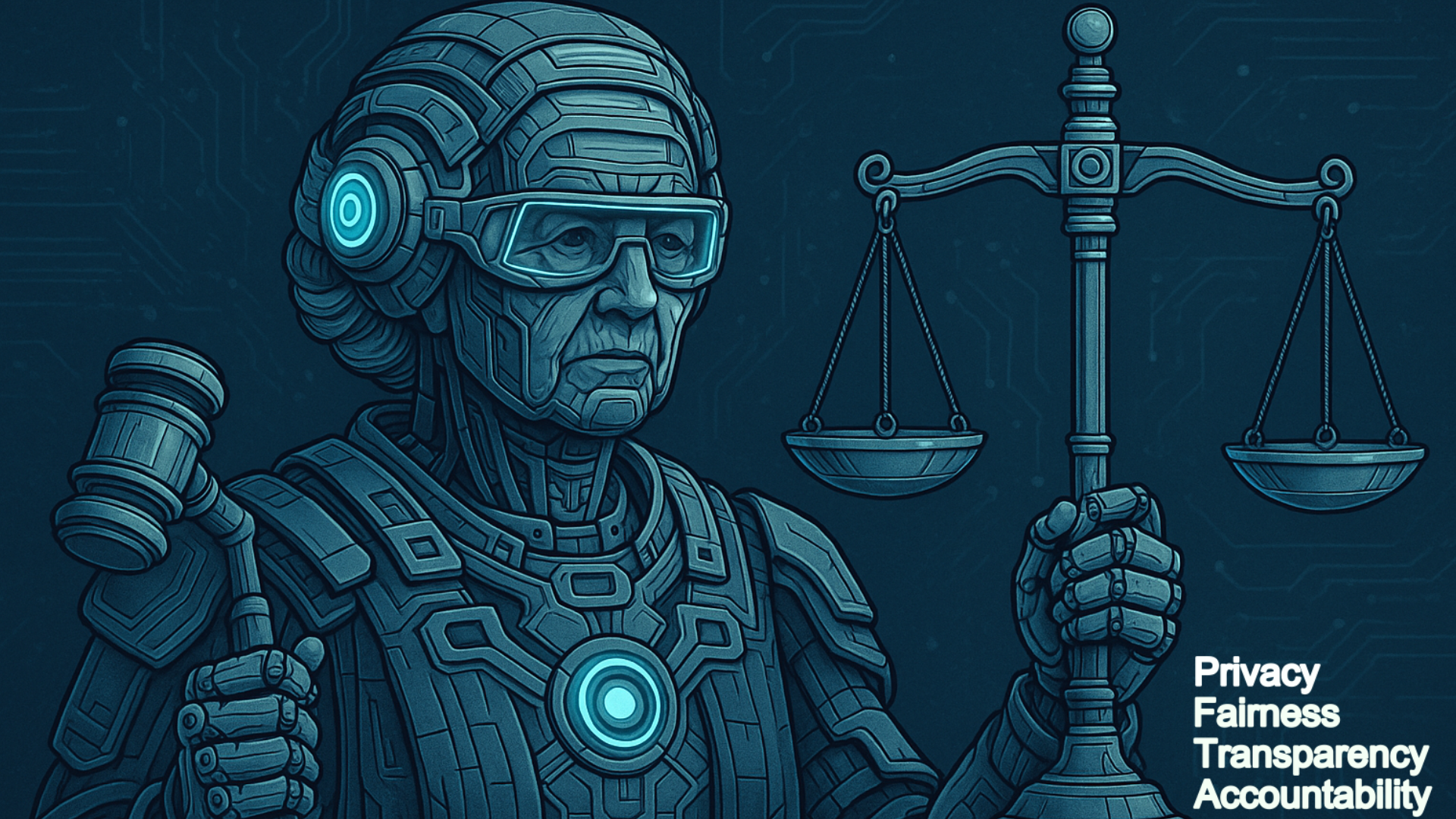AI Governance: Building Ethical AI Systems
As artificial intelligence continues to transform industries and society, organizations face increasing pressure to ensure their AI systems are developed and deployed responsibly. Effective AI governance—the framework of policies, processes, and roles that guide how an organization manages AI technologies—has become a critical business imperative. In this comprehensive guide, we explore the latest approaches, frameworks, and best practices for implementing robust AI governance to build ethical AI systems.
The Evolving Landscape of AI Governance
The field of AI governance has matured significantly in recent years, driven by several key factors:
- Regulatory Momentum: The EU AI Act, China's Algorithm Regulations, and emerging U.S. frameworks are creating a complex global regulatory landscape requiring proactive compliance strategies.
- Public Scrutiny: High-profile AI failures and controversies have heightened public awareness and demands for responsible AI development.
- Corporate Responsibility: Leading organizations recognize that ethical AI is not merely a compliance exercise but a competitive advantage that builds customer trust and mitigates risks.
- Technological Complexity: The rapid advancement of AI capabilities, particularly in generative AI and autonomous systems, has introduced new ethical challenges requiring sophisticated governance approaches.
According to a recent McKinsey survey, 78% of executives now consider AI ethics and governance "very" or "extremely" important—a 23% increase from just two years ago. However, only 31% report having comprehensive governance frameworks in place, highlighting a significant gap between awareness and implementation.
Core Components of Effective AI Governance
A comprehensive AI governance framework consists of several interconnected elements that work together to ensure ethical AI development and deployment:
1. Organizational Structure and Leadership
Effective AI governance begins with clear roles, responsibilities, and leadership commitment:
- Executive Sponsorship: C-suite involvement signals organizational commitment and ensures appropriate resource allocation for AI governance initiatives.
- AI Ethics Committee/Board: A cross-functional team providing oversight, guidance, and decision-making on ethical questions related to AI development and use.
- Chief AI Ethics Officer: A senior role dedicated to leading AI governance efforts, embedding ethical considerations into business operations, and serving as a bridge between technical teams and executive leadership.
- AI Ethics Champions: Designated individuals within development teams who receive specialized training and serve as frontline resources for ethical questions.
Leading Practice: Microsoft's Office of Responsible AI implements a hub-and-spoke model where a central ethics team develops governance frameworks and tools, while designated champions within product teams drive implementation. This approach has successfully scaled ethical oversight across thousands of AI initiatives.
2. Principles, Policies, and Standards
Organizations need clear guidelines that translate high-level ethical principles into actionable requirements:
- AI Ethical Principles: Core values guiding AI development and use (e.g., transparency, fairness, accountability, privacy, and safety).
- Domain-Specific Policies: Tailored guidelines for different AI applications, addressing the unique ethical challenges in areas like healthcare, finance, human resources, etc.
- Technical Standards: Specific requirements for model documentation, testing protocols, performance thresholds, and monitoring procedures.
- Decision Frameworks: Structured approaches for addressing ethical dilemmas and making difficult trade-offs between competing values.
Implementation Example: IBM's AI Ethics Board developed a multi-tier policy framework that includes both universal principles and application-specific guidelines. For high-risk domains like healthcare and financial services, they maintain detailed requirements covering data quality, model explainability, human oversight, and ongoing monitoring.
3. Risk Assessment and Management Processes
Systematic approaches for identifying, evaluating, and mitigating ethical risks throughout the AI lifecycle:
- AI Impact Assessment: A structured process to evaluate potential ethical, social, and legal implications of proposed AI systems before development begins.
- Risk Categorization Framework: A system for classifying AI applications based on risk levels, with corresponding governance requirements scaled appropriately.
- Ethics Review Process: A formal workflow for evaluating high-risk AI applications, including documentation requirements, review stages, and approval authorities.
- Continuous Monitoring: Ongoing evaluation of deployed AI systems to detect emerging risks, performance degradation, or changing societal expectations.
Practical Tool: The Algorithmic Impact Assessment (AIA) framework, originally developed by Canada's Treasury Board Secretariat and since adapted by numerous organizations, provides a structured approach to evaluating potential harms of automated decision systems. Organizations typically customize AIAs to their specific context, adding industry-relevant risk factors and mitigation strategies.
Emerging Standards and Frameworks
Several influential frameworks have emerged to guide AI governance implementation:
| Framework | Organization | Key Strengths | Best Suited For |
|---|---|---|---|
| AI Risk Management Framework (AI RMF) | NIST (US) | Comprehensive risk management approach; aligned with existing enterprise risk frameworks | Organizations with mature risk management processes seeking integration with existing governance |
| Framework for Trustworthy AI | European Commission | Detailed guidance on implementing technical and non-technical requirements for AI trustworthiness | Organizations operating in or selling to European markets; those seeking preparation for EU AI Act |
| Responsible AI Framework | Singapore PDPC | Practical implementation guidance with strong focus on governance structures and processes | Organizations establishing AI governance from the ground up; Asian market preparation |
| Ethics Guidelines for Trustworthy AI | OECD | Internationally recognized principles with broad consensus from 38 member countries | Multinational organizations needing globally consistent ethical foundation |
While these frameworks provide valuable guidance, most organizations adopt a hybrid approach, combining elements from multiple frameworks based on their specific industry, risk profile, and geographical footprint.
Implementing Governance Across the AI Lifecycle
Effective AI governance must address ethical considerations at each stage of the AI lifecycle:
1. Planning and Design Phase
Key governance activities during initial planning include:
- Problem Framing: Clearly articulating the purpose, scope, and objectives of the AI system, including explicit identification of who will benefit and who might be harmed.
- AI Impact Assessment: Conducting a thorough evaluation of potential ethical, social, and legal implications before development begins.
- Stakeholder Engagement: Identifying and consulting affected communities, particularly those who might experience adverse impacts.
- Data Strategy: Developing plans for responsible data collection, annotation, and governance, with particular attention to consent, representation, and privacy considerations.
Best Practice: Leading organizations use standardized documentation templates for AI system proposals that explicitly capture ethical considerations. Google's Model Cards and Microsoft's Transparency Notes provide useful frameworks that can be adapted for internal use.
2. Development and Testing Phase
During model development, key governance activities include:
- Dataset Documentation: Creating comprehensive documentation of dataset composition, collection methods, limitations, and potential biases.
- Bias Measurement and Mitigation: Systematically testing for and addressing unfair biases across different demographic groups and contexts.
- Explainability Implementation: Building appropriate explainability mechanisms based on the use case, risk level, and stakeholder needs.
- Security Testing: Conducting rigorous security assessments, including adversarial testing and vulnerability analysis.
- Performance Documentation: Thoroughly documenting model capabilities, limitations, edge cases, and failure modes.
Emerging Practice: Ethical "red teaming" involves dedicated cross-functional teams attempting to identify potential misuses, harms, or unexpected behaviors of AI systems before deployment. This approach has proven particularly effective for generative AI systems, where traditional testing may not capture all potential outputs.
3. Deployment and Monitoring Phase
Once AI systems are deployed, governance focus shifts to:
- Human Oversight: Implementing appropriate human review processes based on the system's autonomy level and risk profile.
- Performance Monitoring: Establishing dashboards and alerts for key performance metrics, with particular attention to fairness, accuracy, and safety indicators.
- Feedback Mechanisms: Creating channels for users and affected individuals to report concerns or unexpected behaviors.
- Periodic Reviews: Conducting scheduled reassessments of deployed AI systems to evaluate continued appropriateness and compliance with evolving standards.
- Incident Response: Developing clear protocols for addressing discovered issues, including decision authorities for potential system modification or shutdown.
Case Study: Financial services firm JP Morgan Chase implemented a multi-tier monitoring framework for their AI systems that includes both technical performance metrics and ethical indicators. Each deployed AI application is assigned a risk tier that determines monitoring frequency, review thresholds, and escalation paths. High-risk applications undergo quarterly ethical reviews even without performance anomalies.
Advanced Governance Approaches for Emerging AI Technologies
As AI capabilities rapidly advance, governance frameworks must evolve to address new challenges:
Generative AI Governance
Large language models (LLMs) and other generative AI systems present unique governance challenges:
- Content Filtering Frameworks: Implementing multi-layered approaches to prevent harmful outputs while minimizing excessive restrictions.
- Prompt Engineering Guidelines: Developing standardized approaches for crafting system prompts that align AI behavior with organizational values.
- Attribution and IP Management: Establishing clear policies for ownership, attribution, and usage rights for AI-generated content.
- Provenance Tracking: Implementing watermarking or other mechanisms to identify AI-generated content and maintain appropriate disclosure.
Emerging Standard: The NIST AI Safety Institute recently published a Risk Management Framework for Generative AI that provides detailed guidance on implementing guardrails, safety testing protocols, and deployment considerations. This framework has been widely adopted within the financial services and healthcare sectors.
Autonomous Systems Governance
For AI systems with high autonomy (e.g., self-driving vehicles, industrial robotics):
- Graduated Autonomy Frameworks: Implementing tiered approaches that increase autonomy levels only after meeting rigorous safety and performance thresholds.
- Simulation Testing Requirements: Developing extensive simulation testing protocols to evaluate behavior across diverse scenarios before real-world deployment.
- Human-AI Interaction Design: Creating clear guidelines for designing appropriate human oversight and intervention capabilities.
- Autonomous Decision Documentation: Implementing comprehensive logging of system decisions and actions to enable accountability and investigation when needed.
Industry Example: The automotive industry has developed a five-level framework for autonomous vehicle governance, with increasingly stringent requirements at each level. This includes specific testing protocols, minimum simulation hours, explainability requirements, and human oversight mechanisms based on the autonomy level.
Building Technical Infrastructure for AI Governance
Effective governance requires appropriate tools and technical infrastructure:
1. Governance Platforms and Tools
- AI Inventories: Centralized registries of all AI systems within an organization, including risk classifications and compliance status.
- Documentation Automation: Tools that facilitate consistent, comprehensive documentation of models, datasets, and deployment specifications.
- Workflow Management: Systems that enforce governance checkpoints and approvals throughout the AI lifecycle.
- Performance Dashboards: Real-time monitoring tools that track key ethical and performance metrics for deployed AI systems.
Vendor Landscape: Several specialized platforms have emerged to support AI governance, including Credo AI, Fiddler AI, and Arthur. These platforms provide capabilities ranging from automated documentation to continuous monitoring for bias, drift, and performance issues.
2. Technical Controls and Safeguards
- Fairness Constraints: Technical mechanisms that enforce fairness requirements during model training and inference.
- Explainability Tools: Libraries and frameworks that generate appropriate explanations for AI decisions based on context and audience.
- Privacy-Enhancing Technologies: Techniques like differential privacy, federated learning, and secure multi-party computation that protect sensitive data.
- Model Cards and Datasheets: Standardized documentation templates that capture essential information about AI systems and their training data.
Open Source Resources: A robust ecosystem of open source tools has emerged to support responsible AI development, including IBM's AI Fairness 360, Google's What-If Tool, Microsoft's Fairlearn, and the Linux Foundation's AI Fairness toolkit. These resources can significantly accelerate the implementation of technical controls.
Creating an AI Governance Maturity Model
Organizations typically evolve through several stages of AI governance maturity:
- Initial Stage: Ad hoc governance activities driven by individual project needs with limited organizational oversight.
- Developing Stage: Basic governance frameworks established with defined principles and initial policies, though implementation remains inconsistent.
- Established Stage: Comprehensive governance program with clear structures, processes, and tools consistently applied across the organization.
- Advanced Stage: Integrated governance embedded throughout the AI lifecycle with continuous improvement mechanisms and influence on business strategy.
- Leading Stage: Proactive governance that anticipates emerging issues, shapes industry standards, and creates competitive advantage through trusted AI.
Organizations can use this maturity model to assess their current state and develop roadmaps for advancing their AI governance capabilities.
Navigating Regulatory Compliance
AI governance must address an increasingly complex regulatory landscape:
Key Regulatory Developments
- EU AI Act: Comprehensive framework categorizing AI systems by risk level with corresponding requirements for high-risk applications, including extensive documentation, human oversight, and robust risk management.
- China's Algorithm Regulations: Detailed rules governing recommendation algorithms, automated decision-making, and data usage, with strong emphasis on transparency and user control.
- US Executive Order on AI: Federal guidelines establishing risk management requirements for AI systems used by government agencies, with additional focus on privacy, civil rights, and consumer protection.
- Canada's Directive on Automated Decision-Making: Mandates impact assessments, transparency, quality assurance, and human oversight for government AI systems.
- Sector-Specific Regulations: Industry-specific requirements in fields like healthcare (FDA), finance (FRB), and employment (EEOC).
Because these regulations often have extraterritorial scope, most organizations need governance frameworks capable of addressing multiple regulatory regimes simultaneously.
Building a Compliance-Ready Governance Program
To navigate this regulatory complexity, organizations should:
- Conduct Regulatory Mapping: Identify all applicable AI regulations based on operational geography, industry, and use cases.
- Implement Documentation Systems: Establish robust documentation practices that capture required information for all relevant regulatory frameworks.
- Develop Unified Compliance Controls: Create comprehensive controls that satisfy the most stringent applicable requirements, allowing for simplified compliance across multiple regimes.
- Establish Regulatory Monitoring: Maintain continuous awareness of evolving regulations and update governance frameworks accordingly.
Strategic Approach: Rather than treating regulatory compliance as a separate workstream, leading organizations integrate compliance requirements into their overall governance framework, ensuring that regulatory considerations are addressed throughout the AI lifecycle.
Building an Ethical AI Culture
Effective governance requires more than just policies and procedures—it demands a supportive organizational culture:
1. Training and Awareness
Organizations need comprehensive education programs for different stakeholder groups:
- Executive Leadership: Strategic-level understanding of AI ethics implications, governance responsibilities, and organizational risks.
- Technical Teams: Detailed training on implementing ethical considerations in AI development, including practical tools and techniques.
- Business Units: Awareness of ethical implications in AI procurement, deployment, and use within specific business contexts.
- All Employees: Basic understanding of organizational AI principles and how to raise concerns about AI systems.
Innovative Approach: Deloitte developed an interactive "Ethics by Design" program that uses scenario-based learning to help technical teams identify and address ethical issues throughout the AI development process. The program includes regular ethics workshops as part of the sprint process rather than separate training sessions.
2. Incentives and Performance Management
Organizations should align incentives with responsible AI development:
- Performance Metrics: Including ethical considerations in performance evaluations for AI teams.
- Recognition Programs: Acknowledging and rewarding exemplary ethical practices in AI development.
- Project Prioritization: Allocating resources based in part on ethical considerations and governance compliance.
- Responsible Outcomes: Measuring success based on responsible deployment rather than just technical performance.
Case Study: Salesforce implemented an "Ethical Use Advisory Council" that reviews AI projects and provides formal recognition for teams that proactively address ethical considerations. This recognition is incorporated into performance reviews and promotion considerations for technical staff.
Measuring AI Governance Effectiveness
To ensure governance programs achieve their objectives, organizations need appropriate metrics and measurement approaches:
Process Metrics
- Percentage of AI systems with completed impact assessments
- Governance review completion rates and timelines
- Documentation completeness scores
- Training completion rates across different stakeholder groups
Outcome Metrics
- Bias incidents and resolution times
- User feedback on AI system fairness and transparency
- Model performance consistency across demographic groups
- Regulatory compliance status
Leading Indicators
- Volume and nature of ethical concerns raised during development
- Employee confidence in raising ethical concerns
- Governance consideration timing in project lifecycle
- Cross-functional collaboration on ethical issues
Measurement Framework: The World Economic Forum's AI Governance Metrics toolkit provides a comprehensive set of metrics organized by governance objective, with implementation guidance for organizations at different maturity levels.
Case Study: Implementing AI Governance in Financial Services
A global financial institution successfully implemented a comprehensive AI governance program:
Challenge
The organization was rapidly expanding its use of AI across lending, fraud detection, customer service, and investment advisory functions. This expansion raised concerns about regulatory compliance, potential bias in customer-facing applications, and inconsistent governance across business units.
Approach
- Governance Structure: Established a centralized AI Ethics Office reporting to the Chief Risk Officer, supported by designated ethics champions in each business unit.
- Risk Tiering Framework: Developed a three-tier classification system for AI applications based on autonomy level, potential impact, and regulatory exposure.
- Lifecycle Integration: Implemented stage-gate reviews at key points in the AI development process, with requirements scaled according to risk tier.
- Technical Infrastructure: Deployed a centralized model inventory and monitoring platform that tracked performance metrics, bias indicators, and explainability measures.
- Culture Development: Conducted role-specific training for over 2,000 employees and integrated ethical AI considerations into performance evaluations for technical teams.
Results
- Successfully deployed 47 AI applications with documented compliance across multiple regulatory regimes
- Identified and mitigated potential bias issues in 28% of AI systems during pre-deployment review
- Reduced governance review timelines by 62% through standardized processes and documentation
- Recognized by regulators as an example of leading practice in AI risk management
Future Trends in AI Governance
Several emerging trends will shape the evolution of AI governance in coming years:
1. Automated Governance
AI itself is increasingly being used to support governance functions:
- Automated Documentation: AI-powered tools that generate and maintain comprehensive documentation of models and datasets.
- Continuous Monitoring: Advanced analytics that detect anomalies, bias patterns, and performance issues in real-time.
- Governance Bots: AI assistants that help developers navigate governance requirements during development.
2. Decentralized Governance
Emerging approaches to distribute governance responsibility:
- Multi-stakeholder Governance: Formal inclusion of external stakeholders, affected communities, and civil society in governance processes.
- Open Governance Frameworks: Collaborative development of shared standards and protocols through industry consortia and open source communities.
- Participatory Design: Direct involvement of end-users and affected communities in the design and oversight of AI systems.
3. AI Assurance and Certification
Growing emphasis on formal verification of AI systems:
- Third-Party Audits: Independent assessment of AI systems against established standards and requirements.
- Certification Programs: Formal certification of AI systems that meet specific ethical and performance criteria.
- AI Assurance Tools: Specialized tools and methodologies for verifying AI behavior across diverse scenarios.
Conclusion: Building a Future-Ready AI Governance Program
As AI becomes increasingly integrated into business operations and society, robust governance is no longer optional—it's essential for responsible innovation, regulatory compliance, and sustainable competitive advantage. Organizations that develop mature governance capabilities will be better positioned to navigate the complex ethical, social, and regulatory landscape of AI while building systems that create lasting value.
By implementing comprehensive governance frameworks that address the entire AI lifecycle, organizations can ensure their AI systems align with ethical principles, comply with regulatory requirements, and maintain the trust of customers, employees, and society.
Ready to Strengthen Your AI Governance?
Straton AI offers specialized consulting services to help organizations design and implement effective AI governance frameworks. Our approach combines industry best practices, regulatory expertise, and practical implementation guidance tailored to your specific needs. Contact us today to begin building more ethical, responsible AI systems.
References and Further Resources:
- NIST AI Risk Management Framework (AI RMF)
- European Commission: Ethics Guidelines for Trustworthy AI
- World Economic Forum: AI Governance Toolkit
- IEEE Global Initiative on Ethics of Autonomous and Intelligent Systems
- Partnership on AI: Responsible AI Research




